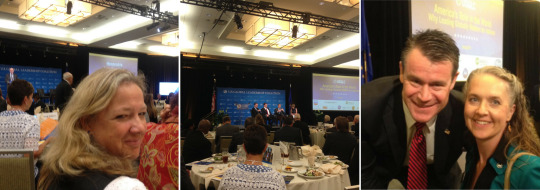Bringing viable alternatives to wicked problems. purdue.edu/dp/ppri
Don't wanna be here? Send us removal request.
Photo

Presence to Influence: Examining the Politics of Representation in Global Environmental Governance
Check out this blog post by PPRI Faculty Policy Fellow Laura Zanotti and colleagues on the politics of representation.
(via Presence to Influence: Examining the Politics of Representation in Global Environmental Governance – Engagement)
0 notes
Photo

Laurel Weldon, Director of PPRI and Distinguished Professor of Political Science will be sharing the stage with Melinda Gates and others at Goalkeepers 2017 in New York. Dr. Weldon’s portion of the event will be livestreamed in Mann Hall. Dr. Weldon will be followed by a host of other impressive speakers including Bill Gates and former President Barack Obama. The rest of the event can be viewed from the Gates Foundation’s YouTube and Facebook pages. More about the event can be found here.
@purdueppri @purduepolsci @purduelibarts @Research_Purdue @LifeAtPurdue @slaurelweldon
0 notes
Photo

Yesterday, Bement Senior Policy Fellow Allison Roberts and I attended the US Global Leadership Coalition’s discussion on America’s Role in the World: Why Leading Globally Matters for Indiana.
The events featured speakers the Honorable Lee Hamilton, Liz Schrayer (President and CEO, USGLC), Senator Todd Young, Ambassador Lee Feinstein, and John Ellenberger of Land O’ Lakes.
This important discussion built the moral, political, economic and security case for maintaining and improving the US commitment to providing leadership abroad on eliminating hunger and poverty, reducing conflict and strengthening our economic ties to the global community.

Speakers emphasized that many consumers on which Indiana business and the US economy more generally depend are outside the country. More than 800,000 jobs in Indiana are supported by trade. The vast majority of companies exporting goods in Indiana are small and medium sized businesses, employing more than 170,000 people.
Indiana’s public Universities, including Purdue and IU, attract large numbers of international students each year, representing billions of dollars. Our economic interests in the state and the nation more generally, then, are intimately tied to the global economy.
Withdrawal is not an option. Understanding our economy requires a deep knowledge of these international connections. We need the diplomatic and development infrastructures, not just investments in defense and the military, to support our economic goals.
Arguments supporting the importance of investing in international affairs infrastructure such as the State department and in USAID are not only economic. We know that diplomacy is critical for international security. If we leave a leadership vacuum on the international scene, there are other nations who will rush will fill it.
Most crucially, this diminishes our sphere of influence, which we may need at some point in the future when we want others to support our initiatives and priorities. Moreover, as Senator Young, Schrayer and others pointed out, aid to those suffering in the aftermath of war or famine is a long-term investment in our own security.
Massive numbers of displaced people - we now have the largest number of refugees in the world since WW2 - destabilize front line states like Jordan. In addition, food scarcity causes conflict, and such instability is a breeding ground for terrorism and weakens protections for human rights. As Senator Young said, roughly paraphrasing Benjamin Franklin, it may be that an ounce of prevention is worth a pound of a cure.
The most powerful arguments for the need for US global leadership centered on the US obligation to defend human rights and freedoms at home and in the world. With great power comes great responsibility, and the US has the ability and thus the obligation to do what it can to feed the hungry, shelter the displaced, and to reduce violence and conflict.
Concrete benefits - including the elimination or reduction of disease, access to medical care, reduction in modern slavery, trafficking and other forms of violence against women - are tangible results of US leadership in the past, and renewed efforts can again result in making the world a better place.
Reducing the proliferation of nuclear weapons, respect for human rights, and reducing poverty, hunger and conflict are not just the right thing to do, they make our world more peaceful and prosperous for all.
If the spirit of bi-partisanship, or non-partisanship, that the event sought to channel can be summoned to work on these important issues, it may be that a better world is indeed possible and even necessary, even in these challenging times.
0 notes
Photo

(via Amazon Planning Drone-Powered Beehive Warehouse for The Future)
0 notes
Photo

Yes...that’s a wienerdrone - hot dog!
(via Oscar Mayer pioneers unmanned aerial hot dog delivery via the Wienerdrone | The Drum)
0 notes
Photo

Firefighting drones? Smart! Someday...
(via Could This Firefighting Drone Be the Wave of the Future? - The Drive)
0 notes
Photo

PPRI-NEXTRANS Postdoctoral Autonomous Vehicle Policy Fellow
Applications are now being accepted for this new postdoctoral fellowship. Deadline for applications is June 15, 2017.
See the position description HERE.
3 notes
·
View notes
Video
youtube
How Purdue's BioWall provides buildings with a breath of fresh air: BTN LiveBIG
Look at any new housing development and you’ll be hard pressed to find one that doesn’t brag about how “energy efficient” it is.
This movement is great for energy consumption and costs, but not quite for the air inside the home. Energy efficient homes are very well insulated, keeping heating and cooling costs low, but they also trap and accumulate volatile organic compounds (VOCs) like carbon dioxide.
A model of a thriving green wall of plants called the BioWall could be the solution.
In a recent presentation about the BioWall, Purdue student Scott Massey explained that while there have been many advances in HVAC efficiency and reducing power consumption, the interiors of homes and offices have suffered.
“Unfortunately this has been horrible for interior air quality,” he said. “In fact, the World Health Organization has named this as one of the biggest causes of future health problems for Americans,.” Massey is part of the team working on the innovative BioWall system, led by Purdue professor Bill Hutzel.
With origins in Purdue’s 2011 Solar Decathlon and borrowing from NASA technology, the BioWall functions as a botanical air filter. “In a controlled chamber, they’ve seen upwards of 90 percentiles for VOC removal rates,” Massey said of the BioWall. Think back to elementary school science class and you’ll recall that plants take in carbon dioxide, process it through photosynthesis, and then give off oxygen.
The BioWall is built into a home or building and contains trays of plants that make up a plant care and air filtration system. It’s a fairly sophisticated system even beyond the air filtering function with watering, light, and airflow all automated. “Our system knows when to turn itself on and off. The day-to-day maintenance to a homeowner is minimal,” says Hutzel.
“While it does reduce the need for outside air, it’s not a big enough savings that it’s going to pay for itself. There’s the potential for savings but nobody is going to buy it purely as an energy saving device.” Hutzel said, “It’s the combination of energy savings, potentially better indoor air quality, and the overall aesthetic [that make the BioWall an attractive feature for homes]. People that enjoy plants really seem to respond to that kind of environment.”
The BioWall in West Lafayette, Indiana contains hardy varieties like spider plants, philodendron, and English ivy, but Hutzel’s current students are branching out beyond houseplants and experimenting with kale. The thought is that someday, if there are BioWalls in people’s homes, they can modify trays of plants seasonally to fit time of year and decor.
What began as purely a tech project, quickly became more multidisciplinary than Hutzel ever anticipated. Hutzel’s work is usually so mechanical, full of sensors, controls, and machines. But the BioWall added a big biological component. “It’s been a lot of fun,” he says.
Teams of students from across Purdue’s campus added a touch of their expertise to the BioWall–technology, engineering, agriculture, biochemistry, horticulture, and interior design.
Originally the BioWall was functional but not necessarily something so attractive you’d want it featured in your house. “We partnered with interior design students to orient it so it’s aesthetically pleasing. There are all those considerations that I wouldn’t necessarily be good at,” said Hutzel.
As for what’s next, Hutzel said that they’re exploring options for licensing agreements with potential partners. Perhaps an HVAC company with a distribution network or one looking to take on BioWall maintenance in homes as an arm of their business. “We’re not 100 percent sure of where we’re going,” says Hutzel, “but the market will dictate what ultimately gets commercialized.”
Written by Betsy Piland
- See more at: http://btn.com/2017/05/05/how-purdues-biowall-provides-buildings-with-a-breath-of-fresh-air-btn-livebig/#sthash.YDqhPlLK.dpuf
0 notes
Photo

PPRI-NEXTRANS Postdoctoral Autonomous Vehicle Policy Fellow
Applications are now being accepted for this new postdoctoral fellowship. Deadline for applications is June 15, 2017.
See the position description HERE.
3 notes
·
View notes
Photo

PPRI-NEXTRANS Postdoctoral Autonomous Vehicle Policy Fellow
Applications are now being accepted for this new postdoctoral fellowship. Deadline for applications is June 15, 2017.
See the position description HERE.
3 notes
·
View notes
Video
youtube
Peeing in the pool is actually really bad for you
Everyone pees in the pool. That’s the safe and well-informed assumption that many chemists studying the safety of public, chlorinated swimming pools make. But let’s face it: once you jump in the pool and smell and feel the chlorine surrounding you, you quickly forget about any potential pool-peers and trust the power of the chemicals in the water. That’s probably not the best idea, though. The chemical byproducts that result from your urine and the chlorine aren’t as benign as you may think. And in the end, everyone would be doing a great public service if they would just stop peeing.
“If this was just one person peeing in the pool, then clearly that would not be a problem,” says Ernest Blatchley, an environmental engineer at Purdue University. “But we have evidence to suggest that there are circumstances where the concentration of these compounds could, in some cases, or in fact have, reached the concentrations that are detrimental to human health.”
First, let’s start with a little chemistry. Urine is made up of tons of different substances, all of which can interact with chlorine. But uric acid and a handful of amino acids pose the biggest threat. When each of these react with chlorine, they create are trichloraminen (sometimes called nitrogen trichloride) and cyanogen chloride. Both of these can be harmful in high enough concentrations.
The problem, says Blatchley, is that it’s incredibly difficult to determine just how concentrated these chemicals are in pool water at any given time. It depends on a whole bunch of other factors: How many people are using the pool, how well mixed it is, how warm the water is, and how long it’s been since someone changed the water.
The amount of trichloramine can be measured, but the tools used to do so aren’t generally available at pools. And cyanogen chloride is even harder to measure. “[It’s] a very dynamic chemical. It forms very rapidly but it also decays very rapidly, and it’s quite volatile,” says Blatchley. What that means, he says, is that once it forms in a pool, it doesn’t stick around very long. Of the two substances, Blatchley says cyanogen chloride is the most concerning. It’s a toxic substance, and once it reaches a high enough level, it can be detrimental to human health. But the problem is that because it forms and decays so quickly, it’s very hard to figure out how high those levels in a pool can get.
Trichloramine can caused respiratory problems when inhaled, especially in folks who already suffer from problems like asthma. It also causes irritation—it's what creates that sometimes-overwhelming pool smell, and makes your eyes burn. Cyanogen chloride is an irritant too, and can actually affect the body's ability to use oxygen. You're not going to get a fatal whiff of the stuff in a pool—no matter how full of pee it is—but breathing it in definitely isn't good for you.
Blatchley says that for the majority of swimming pools, and the majority of the time, the levels of cyanogen chloride won’t reach toxic levels. However, he says, that there are certain conditions in which that chemical could accumulate to unacceptably high concentrations—when you have a really crowded pool, for example.
“I think pretty much any pool that you put people in, you can count on people peeing in [it],” Blatchley says. Based on data that he and his team have conducted, as well a multitude of other studies done, he estimates that the average swimmer leaves behind somewhere between 50 and 80 milliliters of urine—”essentially a shot glass full of urine per swimmer.”
If everyone is peeing, why don’t we just chlorinate our pools more? Blatchley says that’s not the solution. The more chlorine you add, the more likely the chemical reactions that create those volatile compounds are to occur. Instead, he says, we should actually be working to disband this culture that it’s okay to pee in the pool.
Blatchley thinks that if people just understood the chemistry, they would think twice before urinating in a pool they're sharing with others. He says he often relates it to secondhand smoking. It wasn’t that long ago that it was culturally acceptable to smoke in public in this country. That changed largely as a result of public pressure that grew out of a scientific understanding of the negative effects of secondhand smoke. “I think we as a culture have evolved to make it unacceptable. If people understood [the same] for pool chemistry, no one would subject their neighbors to cyanogen chloride.”
Even Michael Phelps—a swimming icon and symbol for both competitive and recreational swimming—has admitted to peeing the pool, commenting that chlorine kills it, so it’s not bad. But in reality, science says the opposite.
What Blatchley suggests is that people stop treating swimming pools like a cleaning machine—take a shower before getting in the pool, and step out to the restroom if you need to urinate. If we can stop this culture of routinely peeing in the pool, we can cut down on our chlorine usage— that would reduce the burden of organic compounds that react with chlorine, which would, in turn, result in less chlorine usage as well as improved water and air quality. In the future, Blatchley says “I’d like to see us take a proactive approach, rather than reactive.”
(via Peeing in the pool is actually really bad for you - Popular Science)
1 note
·
View note
Video
youtube
‘Instantly rechargeable’ battery could change the future of electric and hybrid automobiles
WEST LAFAYETTE, Ind. – A technology developed by Purdue researchers could provide an “instantly rechargeable” method that is safe, affordable and environmentally friendly for recharging electric and hybrid vehicle batteries through a quick and easy process similar to refueling a car at a gas station.
The innovation could expedite the adoption of electric and hybrid vehicles by eliminating the time needed to stop and re-charge a conventional electric car’s battery and dramatically reducing the need for new infrastructure to support re-charging stations.
John Cushman, Purdue University distinguished professor of earth, atmospheric and planetary science and a professor of mathematics, presented the research findings “Redox reactions in immiscible-fluids in porous media – membraneless battery applications” at the recent International Society for Porous Media 9th International Conference in Rotterdam, Netherlands.
Cushman co-founded Ifbattery LLC (IF-battery) to further develop and commercialize the technology.
“Electric and hybrid vehicle sales are growing worldwide and the popularity of companies like Tesla is incredible, but there continues to be strong challenges for industry and consumers of electric or hybrid cars,” said Cushman, who led the research team that developed the technology. “The biggest challenge for industry is to extend the life of a battery’s charge and the infrastructure needed to actually charge the vehicle. The greatest hurdle for drivers is the time commitment to keeping their cars fully charged.”
John Cushman, Purdue University distinguished professor of earth, atmospheric and planetary science and a professor of mathematics, is commercializing a technology that could provide an “instantly rechargeable” method forelectric and hybrid vehicle batteries through a quick and easy process similar to refueling a car at a gas station.
Download image
Current electric cars need convenient locations built for charging ports.
“Designing and building enough of these recharging stations requires massive infrastructure development, which means the energy distribution and storage system is being rebuilt at tremendous cost to accommodate the need for continual local battery recharge,” said Eric Nauman, co-founder of Ifbattery and a Purdue professor of mechanical engineering, basic medical sciences and biomedical engineering. “Ifbattery is developing an energy storage system that would enable drivers to fill up their electric or hybrid vehicles with fluid electrolytes to re-energize spent battery fluids much like refueling their gas tanks.”
The spent battery fluids or electrolyte could be collected and taken to a solar farm, wind turbine installation or hydroelectric plant for re-charging.
“Instead of refining petroleum, the refiners would reprocess spent electrolytes and instead of dispensing gas, the fueling stations would dispense a water and ethanol or methanol solution as fluid electrolytes to power vehicles,” Cushman said. “Users would be able to drop off the spent electrolytes at gas stations, which would then be sent in bulk to solar farms, wind turbine installations or hydroelectric plants for reconstitution or re-charging into the viable electrolyte and reused many times. It is believed that our technology could be nearly ‘drop-in’ ready for most of the underground piping system, rail and truck delivery system, gas stations and refineries.”
Mike Mueterthies, Purdue doctoral teaching and research assistant in physics and the third co-founder of Ifbattery, said the flow battery system makes the Ifbattery system unique.
“Other flow batteries exist, but we are the first to remove membranes which reduces costs and extends battery life,” Mueterthies said.
Ifbattery’s membrane-free battery demonstrates other benefits as well.
“Membrane fouling can limit the number of recharge cycles and is a known contributor to many battery fires,” Cushman said. “Ifbattery’s components are safe enough to be stored in a family home, are stable enough to meet major production and distribution requirements and are cost effective.”
Ifbattery licensed part of the technology through the Purdue Research Foundation Office of Technology Commercialization and has developed patents of its own. The company is a member of the Purdue Startup Class of 2017. Click https://youtu.be/LskSvhrjSjE to view a video about the company.
“We are at a stage in the company’s growth that we are looking for additional financing to build large-scale prototypes and subsequently manufacturing partners,” Cushman said.
Writer: Cynthia Sequin, 765-588-3340, [email protected]
Sources: ��John Cushman, 765-494-8040, [email protected]
Eric Nauman, [email protected]
Michael Mueterthies,
(via 'Instantly rechargeable' battery could change the future of electric and hybrid automobiles - Purdue University)
0 notes
Photo

PPRI-NEXTRANS Postdoctoral Autonomous Vehicle Policy Fellow
Applications are now being accepted for this new postdoctoral fellowship. Deadline for applications is June 15, 2017.
See the position description HERE.
3 notes
·
View notes
Photo

Up-to-date scientific research findings are not just found in journals. For a variety of reasons, more and more academic researchers are finding time during their busy days to read and even write science blogs. This trend is on the rise and creates new opportunities for scientists to share their research and engage with the public.
In a 2015 survey of scientists who use social media, 92 percent indicated that they read science blogs. And according to a 2014 survey of more than 600 science bloggers, 47 percent identified themselves as working in academic research, indicating that blogging has become more of an accepted practice at universities.
The number of science blogs seems to also grow daily. The site ScienceSeeker.org has links to more than 2,300 blogs and other science news sources. The diversity of science blogs includes the more commonly covered biology and climate science and also topics such as paleontology, political science and astronomy.
Reasons for blogging vary, but include the ability to explain science; draw attention to science that is not normally covered in mainstream media, and the opportunity to share one’s work with colleagues. While research in this area is limited, there is some indication that scientists who do promote their work through social media do receive more citations based on a study of nanotechnology researchers.
For those who wish to join the “blogosphere” there are some points for how to make the most of that effort. First, identify the role of your blog. Do you want to promote scientific information in general; share insights with colleagues; highlight research from your lab; or try to explain current scientific discoveries covered in the news. The best blogs do have a “voice” or specific role for which those who read it come to expect. Also make sure to identify who you are and your scientific expertise.
How content is provided in the blog is also important. Photos and videos are easily shared by others through social media and help provide interest. People always like to hear stories, so sharing the story behind a discovery or anecdote about personal experience can make it more interesting. Practical information or “how to” advice is also popular.
There are numerous resources on the web to also help you determine what platform to use (WordPress, Blogger or Tumblir for example) and how to promote your blog.
As most people now get their science information from the web, blogging is a great addition to traditional science news coverage. It can add interest, clarify, highlight and reach new audiences with science information.
– Beth Forbes, director of science communication, College of Agriculture ([email protected])
(via BLOGGING: IT’S ACADEMIC – Dimensions of Discovery)
0 notes
Photo

Mars spaghetti maker feeds Earthlings first
(via Mars spaghetti maker feeds Earthlings first | Particle)
0 notes
Photo

TODAY, April 26th is Purdue Day of Giving, when the Purdue community will rally all together to fulfill the promise begun by John Purdue to provide higher education at the highest proven value.
Last year, Purdue Day of Giving raised a record breaking $18.3 million in just 24 hours, granting countless opportunities for our community. Join us this year, as we grant bigger and better opportunities and create lasting impact. Together we can build a better stronger and more affordable Purdue.
Through challenges, interactive leaderboards, and some good old-fashioned rivalry, participants are motivated to give back in hopes of pushing their favorite college, school, program, unit or student organization to the top.
Put the Purdue Policy Research Institute (PPRI) at the top of the leaderboard by participating in one of the many challenges. Purdue Day of Giving features hourly donation contests (all times in Eastern Standard Time) – and the best part is that the number of donations are what matters, not size! Your gift of $10 or more, could help PPRI win even more money to promote the policy impact of Purdue discoveries!
Please make a donation to PPRI by selecting the following:
Participant: "Discovery Park”
Fund: “Other”
Type in “PPRI” in the space below the drop-down menus.
The link to donate and access the leaderboard is:
https://dayofgiving.purdue.edu/donate/
0 notes
